2ed7ad17d73f8c8e62493534ba0137fe.ppt
- Количество слайдов: 137
 Social-Communication Skills in Students with Autism Spectrum Disorders (ages 1122) Module 4 Exceptional Children Division, NCDPI Prepared by Project LINK Center for Development and Learning Carolina Institute for Developmental Disabilities University of North Carolina at Chapel Hill 1
Social-Communication Skills in Students with Autism Spectrum Disorders (ages 1122) Module 4 Exceptional Children Division, NCDPI Prepared by Project LINK Center for Development and Learning Carolina Institute for Developmental Disabilities University of North Carolina at Chapel Hill 1
 SECTION 1 Typical Development of Social. Communication Skills Differences in Social-Communication Skills in Students with ASD 2
SECTION 1 Typical Development of Social. Communication Skills Differences in Social-Communication Skills in Students with ASD 2
 Typical Development of Social-Communication Skills 3
Typical Development of Social-Communication Skills 3
 Social-Communication: Definition Social-Communication, also known as “pragmatics, ” refers to the way in which a speaker and communication partner use language to interact with one another (Levinson, 1983) In other words: “Knowing when to say what to whom, and how much to say. ” (Hymes, 1971) 4
Social-Communication: Definition Social-Communication, also known as “pragmatics, ” refers to the way in which a speaker and communication partner use language to interact with one another (Levinson, 1983) In other words: “Knowing when to say what to whom, and how much to say. ” (Hymes, 1971) 4
 Typical Social-Communication Skills of an Adolescent Verbal aspects Paralinguistic aspects Nonverbal aspects (From Prutting & Kirchner, 1983) 5
Typical Social-Communication Skills of an Adolescent Verbal aspects Paralinguistic aspects Nonverbal aspects (From Prutting & Kirchner, 1983) 5
 Verbal Aspects Speech acts – Understands speaker and listener role relative to context – Uses a variety of speech acts such as commenting, asking questions, making a request, etc. 6
Verbal Aspects Speech acts – Understands speaker and listener role relative to context – Uses a variety of speech acts such as commenting, asking questions, making a request, etc. 6
 Verbal Aspects Topic of conversation – Selects – Introduces – Maintains – Changes 7
Verbal Aspects Topic of conversation – Selects – Introduces – Maintains – Changes 7
 Verbal Aspects Turn taking – Initiates – Responds – Repairs communication breakdowns – Pauses – Avoids interruption 8
Verbal Aspects Turn taking – Initiates – Responds – Repairs communication breakdowns – Pauses – Avoids interruption 8
 Verbal Aspects Turn taking (continued) – Provides feedback to speakers – Produces utterances occurring immediately after the speaker’s utterances – Provides utterances that share the same topic as that of the speaker then adds additional information – Provides only needed information 9
Verbal Aspects Turn taking (continued) – Provides feedback to speakers – Produces utterances occurring immediately after the speaker’s utterances – Provides utterances that share the same topic as that of the speaker then adds additional information – Provides only needed information 9
 Verbal Aspects Lexical selection – Is specific and accurate – Is cohesive Stylistic variations – Varies communicative styles 10
Verbal Aspects Lexical selection – Is specific and accurate – Is cohesive Stylistic variations – Varies communicative styles 10
 Paralinguistic Aspects Exhibits appropriate: – Intelligibility – Vocal intensity – Vocal quality – Prosody – Fluency 11
Paralinguistic Aspects Exhibits appropriate: – Intelligibility – Vocal intensity – Vocal quality – Prosody – Fluency 11
 Activity: “I didn’t say she stole my money. ” I didn’t say she stole my money. 12
Activity: “I didn’t say she stole my money. ” I didn’t say she stole my money. 12
 Nonverbal Aspects Exhibits appropriate: – Physical proximity – Physical contacts – Body posture – Foot/leg and hand/arm movements – Gestures – Facial expression – Eye gaze 13
Nonverbal Aspects Exhibits appropriate: – Physical proximity – Physical contacts – Body posture – Foot/leg and hand/arm movements – Gestures – Facial expression – Eye gaze 13
 Activity: Tatekudasai (Ta-teh-kuu-dah-sigh) Sorekara (So-de-ka-da) Suattekudasai (Sue-ot (as in hot)-teh-kuudah-sigh) 14
Activity: Tatekudasai (Ta-teh-kuu-dah-sigh) Sorekara (So-de-ka-da) Suattekudasai (Sue-ot (as in hot)-teh-kuudah-sigh) 14
 Differences in Social-Communication Skills in Students with ASD 15
Differences in Social-Communication Skills in Students with ASD 15
 Differences in Social-Communication in Individuals with ASD Differences in social skills Differences in communication Differences within both areas Social. Communication 16
Differences in Social-Communication in Individuals with ASD Differences in social skills Differences in communication Differences within both areas Social. Communication 16
 Social Differences Social-emotional understanding Empathy Taking others’ perspectives Lack of insight into peer relationships Shared enjoyment in activities 17
Social Differences Social-emotional understanding Empathy Taking others’ perspectives Lack of insight into peer relationships Shared enjoyment in activities 17
 Communication Differences Intonation Stereotyped phrases Formal language 18
Communication Differences Intonation Stereotyped phrases Formal language 18
 Differences in Both Socialization and Communication Conversation – Initiation of conversation – Appropriate topics of conversation – Maintaining a reciprocal conversation – Reporting of events/Offering information 19
Differences in Both Socialization and Communication Conversation – Initiation of conversation – Appropriate topics of conversation – Maintaining a reciprocal conversation – Reporting of events/Offering information 19
 Differences in Both Socialization and Communication Nonverbal communication – Eye contact – Use of gestures – Facial expressions (directing them to others, reading others’ faces) 20
Differences in Both Socialization and Communication Nonverbal communication – Eye contact – Use of gestures – Facial expressions (directing them to others, reading others’ faces) 20
 Social-Communication Screening Tools Children’s Communication Checklist-2 Clinical Evaluation of Language Fundamentals-4 th Edition: Pragmatic Profile Pragmatic Protocol Pragmatic Communication Skills Protocol NC DPI Pragmatic Language Checklist (*optional handout) 21
Social-Communication Screening Tools Children’s Communication Checklist-2 Clinical Evaluation of Language Fundamentals-4 th Edition: Pragmatic Profile Pragmatic Protocol Pragmatic Communication Skills Protocol NC DPI Pragmatic Language Checklist (*optional handout) 21
 Pragmatic Language Assessments Comprehensive Assessment of Spoken Language: Pragmatic Judgment subtest Test of Pragmatic Language-2 nd Edition (* optional handout) 22
Pragmatic Language Assessments Comprehensive Assessment of Spoken Language: Pragmatic Judgment subtest Test of Pragmatic Language-2 nd Edition (* optional handout) 22
 Autism Assessment Measures: Social-Communication Skills By design, assess social and communication skills Screening – Social-Communication Questionnaire – Social Responsiveness Scale Autism measures (ADOS; ADI-R) – Review scoring and reports for target skills (* optional handout) 23
Autism Assessment Measures: Social-Communication Skills By design, assess social and communication skills Screening – Social-Communication Questionnaire – Social Responsiveness Scale Autism measures (ADOS; ADI-R) – Review scoring and reports for target skills (* optional handout) 23
 Section 2 Impact of Emotional Factors on Social-Communication 24
Section 2 Impact of Emotional Factors on Social-Communication 24
 “ Iceberg ” Theory Specific Behaviors Underlying Deficits Iceberg Concept from Division TEACCH 25
“ Iceberg ” Theory Specific Behaviors Underlying Deficits Iceberg Concept from Division TEACCH 25
 Iceberg Activity 26
Iceberg Activity 26
 Underlying Emotional Factors Anxiety/Fear Anger/Frustration Depression 27
Underlying Emotional Factors Anxiety/Fear Anger/Frustration Depression 27
 Impact on Social-Communication Challenges – Approaching others – Having conversations – Positive peer interactions – Developing friendships – Trying new activities Resulting in… – Withdrawal and isolation – Behavioral outbursts – Social rejection – Limited experiences 28
Impact on Social-Communication Challenges – Approaching others – Having conversations – Positive peer interactions – Developing friendships – Trying new activities Resulting in… – Withdrawal and isolation – Behavioral outbursts – Social rejection – Limited experiences 28
 Anxiety 29
Anxiety 29
 Anxiety - Overview Prevalence rates Symptoms/Types – Physiological arousal, separation anxiety, panic, social anxiety – Excessive fear and worry for social situations 30
Anxiety - Overview Prevalence rates Symptoms/Types – Physiological arousal, separation anxiety, panic, social anxiety – Excessive fear and worry for social situations 30
 Causes for Anxiety in Students with ASD Environmental over-stimulation – Sensory stimuli, people, settings Internal over- or under-stimulation – Emotions - positive and negative – Physical needs- hunger, thirst, need for bathroom, pain – Boredom – don’t know what to do with down time 31
Causes for Anxiety in Students with ASD Environmental over-stimulation – Sensory stimuli, people, settings Internal over- or under-stimulation – Emotions - positive and negative – Physical needs- hunger, thirst, need for bathroom, pain – Boredom – don’t know what to do with down time 31
 Anger and Frustration 32
Anger and Frustration 32
 Anger Model (Baker, 2005) Trigger → Thoughts → Feelings 33
Anger Model (Baker, 2005) Trigger → Thoughts → Feelings 33
 Triggers Change the triggers Change your thoughts/actions Find calming strategies – Self-talk, distractions Talk about, don’t act out feelings Importance of practicing! 34
Triggers Change the triggers Change your thoughts/actions Find calming strategies – Self-talk, distractions Talk about, don’t act out feelings Importance of practicing! 34
 Trigger Activity Identify trigger Teacher called name in class Identify old thought/new thought Picking on me Wants me to have turn Identify old/new feeling (behavior) Angry (throw book on floor) Not angry but still anxious (one word response or head shake) 35
Trigger Activity Identify trigger Teacher called name in class Identify old thought/new thought Picking on me Wants me to have turn Identify old/new feeling (behavior) Angry (throw book on floor) Not angry but still anxious (one word response or head shake) 35
 Depression 36
Depression 36
 Depression Common in persons with ASD – Greatest risk in adolescence/young adulthood Treatments may include: – CBT – Medication 37
Depression Common in persons with ASD – Greatest risk in adolescence/young adulthood Treatments may include: – CBT – Medication 37
 Evidenced-Based Interventions for Students with ASD Cognitive Behavioral Therapy (CBT) – a psychotherapeutic approach that aims to influence dysfunctional emotions, behaviors and cognitions through a goal-oriented, systematic procedure Individual or group 38
Evidenced-Based Interventions for Students with ASD Cognitive Behavioral Therapy (CBT) – a psychotherapeutic approach that aims to influence dysfunctional emotions, behaviors and cognitions through a goal-oriented, systematic procedure Individual or group 38
 Basic CBT Model Thoughts Feelings Behavior 39
Basic CBT Model Thoughts Feelings Behavior 39
 Evidenced-Based Interventions for Students with ASD - CBT Cognitive Behavioral Therapy – modifications – Expanded emotion education – Adding peer buddy and play date programs – Social coaching – Focus on independence/self-help skills 40
Evidenced-Based Interventions for Students with ASD - CBT Cognitive Behavioral Therapy – modifications – Expanded emotion education – Adding peer buddy and play date programs – Social coaching – Focus on independence/self-help skills 40
 More Evidenced-Based Procedures Behavioral interventions – Modeling – Shaping – Reinforcement Social narratives Video modeling/self-modeling Visual supports 41
More Evidenced-Based Procedures Behavioral interventions – Modeling – Shaping – Reinforcement Social narratives Video modeling/self-modeling Visual supports 41
 Social Narratives Cafeteria Noise It is very noisy in the cafeteria. It makes me upset and I want to leave. When I feel like I’m going to run out, I will show my ‘I need a break’ card to the teacher. I will walk slowly to the door and down the hall to Mr. Garrett’s office. I will sit in his rocking chair and rock until my breathing slows down. When the bell rings, I will go to my next class which is. 42
Social Narratives Cafeteria Noise It is very noisy in the cafeteria. It makes me upset and I want to leave. When I feel like I’m going to run out, I will show my ‘I need a break’ card to the teacher. I will walk slowly to the door and down the hall to Mr. Garrett’s office. I will sit in his rocking chair and rock until my breathing slows down. When the bell rings, I will go to my next class which is. 42
 Video Modeling Video modeling is a form of observational learning in which desired behaviors are learned by watching a video demonstration and then imitating the behavior of the model. In video self -modeling (VSM), individuals observe themselves performing a behavior successfully on video, and then imitate the targeted behavior. 43
Video Modeling Video modeling is a form of observational learning in which desired behaviors are learned by watching a video demonstration and then imitating the behavior of the model. In video self -modeling (VSM), individuals observe themselves performing a behavior successfully on video, and then imitate the targeted behavior. 43
 Emotion/Feelings Thermometer EXPLODING!! 10 Use to get baseline information on emotions. Angry Cross or Irritated to monitor feelings Calm during stressful situations Furious –– –– –– 9 8 7 6 5 4 3 2 1 The Anger Thermometer 44
Emotion/Feelings Thermometer EXPLODING!! 10 Use to get baseline information on emotions. Angry Cross or Irritated to monitor feelings Calm during stressful situations Furious –– –– –– 9 8 7 6 5 4 3 2 1 The Anger Thermometer 44
 Visual Supports for Emotions Choice of preferred (calm) activity 45
Visual Supports for Emotions Choice of preferred (calm) activity 45
 Visual Supports for Emotions Don’t Talk to Me 5 minute CHILL! I Am Upset Need a Coke Break 46
Visual Supports for Emotions Don’t Talk to Me 5 minute CHILL! I Am Upset Need a Coke Break 46
 Other Strategies to Address Emotions Teaching emotions Relaxation Problem-solving 47
Other Strategies to Address Emotions Teaching emotions Relaxation Problem-solving 47
 Teaching Emotion Recognition Emotion words Facial expressions Emotions in self/others – How does my face look? – What thoughts do I have? – How does my body move? – How does my voice change? 48
Teaching Emotion Recognition Emotion words Facial expressions Emotions in self/others – How does my face look? – What thoughts do I have? – How does my body move? – How does my voice change? 48
 Relaxation Meditation, deep breathing, preferred activities, progressive muscle relaxation strategies Have a relaxation plan or routine Practice! 49
Relaxation Meditation, deep breathing, preferred activities, progressive muscle relaxation strategies Have a relaxation plan or routine Practice! 49
 Teaching a Relaxation Exercises Relaxation Routine 1. Take 3 deep breaths 2. Tense and relax face 3 times Breathing Muscle tense and relax Imagery 3. Take 3 deep breaths 4. Tense and relax shoulders 3 times 5. Take 3 deep breaths 6. Tense and relax arms 3 times 7. Take 3 deep breaths 8. Tense and relax legs 3 times 9. Take 3 deep breaths 10. Think about a vacation 11. Go back to your schedule 50
Teaching a Relaxation Exercises Relaxation Routine 1. Take 3 deep breaths 2. Tense and relax face 3 times Breathing Muscle tense and relax Imagery 3. Take 3 deep breaths 4. Tense and relax shoulders 3 times 5. Take 3 deep breaths 6. Tense and relax arms 3 times 7. Take 3 deep breaths 8. Tense and relax legs 3 times 9. Take 3 deep breaths 10. Think about a vacation 11. Go back to your schedule 50
 Define a Safe or Calming Spot Room A piece of furniture An area 51
Define a Safe or Calming Spot Room A piece of furniture An area 51
 Coping Cards When I feel angry or frustrated, I can take a break. During my break I will do these things to chill out: 1. Take 2 deep breaths. 2. Say, “I can calm down. I need to relax. ” 3. Take 2 deep breaths. 4. Count to 10 slowly. 5. Take 2 deep breaths. When I finish chilling out, I will return to class. I will be ready to speak calmly to my teacher and finish my work. 52
Coping Cards When I feel angry or frustrated, I can take a break. During my break I will do these things to chill out: 1. Take 2 deep breaths. 2. Say, “I can calm down. I need to relax. ” 3. Take 2 deep breaths. 4. Count to 10 slowly. 5. Take 2 deep breaths. When I finish chilling out, I will return to class. I will be ready to speak calmly to my teacher and finish my work. 52
 Problem-Solving – Turtle Technique 1. Recognize angry feelings in self. 2. Think “stop. ” 3. Pull into shell; take deep breaths; think calming thoughts. 4. Come out of shell and act appropriately. 53
Problem-Solving – Turtle Technique 1. Recognize angry feelings in self. 2. Think “stop. ” 3. Pull into shell; take deep breaths; think calming thoughts. 4. Come out of shell and act appropriately. 53
 Case Story – Paul 11 -year-old boy; diagnosed with high functioning autism at age 4 due to limited peer interaction, repetitive interests and stereotyped speech School – 6 th grade, just started middle school Family – lives with parents and 8 -year-old sister 54
Case Story – Paul 11 -year-old boy; diagnosed with high functioning autism at age 4 due to limited peer interaction, repetitive interests and stereotyped speech School – 6 th grade, just started middle school Family – lives with parents and 8 -year-old sister 54
 Paul (cont. ) Interests – hot water heaters; mechanical things Social – limited and awkward interaction with peers; difficulty with pace of conversations and staying on topic Behavior – anxiousness; some stereotyped behaviors and self-injury 55
Paul (cont. ) Interests – hot water heaters; mechanical things Social – limited and awkward interaction with peers; difficulty with pace of conversations and staying on topic Behavior – anxiousness; some stereotyped behaviors and self-injury 55
 Activity – Challenging Scenario Paul is anxiously walking down the hall to Math class. Another student is talking to a friend and bumps into Paul, knocking his books out of his hand. Paul becomes furious, yells out at the other student, bangs his fist on a locker, and begins biting his wrist. He continues this behavior and is late for class. The counselor is called to come get Paul and call his parents. 56
Activity – Challenging Scenario Paul is anxiously walking down the hall to Math class. Another student is talking to a friend and bumps into Paul, knocking his books out of his hand. Paul becomes furious, yells out at the other student, bangs his fist on a locker, and begins biting his wrist. He continues this behavior and is late for class. The counselor is called to come get Paul and call his parents. 56
 SECTION 3 Reading Nonverbal Cues and Body Language Having a Conversation 57
SECTION 3 Reading Nonverbal Cues and Body Language Having a Conversation 57
 Case Story - Jessica 13 -year-old girl with Asperger’s Disorder School: 7 th grade; Regular education classrooms; Solid average cognitive, academic, receptive, and expressive language skills. Family: Lives at home with her mother; her parents are divorced. Father lives in a town nearby and has regular visitation every other weekend at least once every week. Jessica is an only child. (* optional handout) 58
Case Story - Jessica 13 -year-old girl with Asperger’s Disorder School: 7 th grade; Regular education classrooms; Solid average cognitive, academic, receptive, and expressive language skills. Family: Lives at home with her mother; her parents are divorced. Father lives in a town nearby and has regular visitation every other weekend at least once every week. Jessica is an only child. (* optional handout) 58
 Jessica (cont. ) Interests: Littlest Pet Shop; Jessica knows every character and every episode of Littlest Pet Shop by heart. Owns many products related to the Littlest Pet Shop. Social: Wants friends, but has difficulty making and keeping them. Doesn’t know why others don’t seem to enjoy being around her; and is easily upset and quick to anger. 59
Jessica (cont. ) Interests: Littlest Pet Shop; Jessica knows every character and every episode of Littlest Pet Shop by heart. Owns many products related to the Littlest Pet Shop. Social: Wants friends, but has difficulty making and keeping them. Doesn’t know why others don’t seem to enjoy being around her; and is easily upset and quick to anger. 59
 Jessica’s Challenges (Part 1) Jessica talks a lot about her favorite topic, the TV show, “Littlest Pet Shop” – Her friends get bored listening to her talk about it but Jessica doesn’t seem to pick up on their nonverbal cues and body language. – Her SLP and teachers think that Jessica might benefit from being taught the following skills: 60
Jessica’s Challenges (Part 1) Jessica talks a lot about her favorite topic, the TV show, “Littlest Pet Shop” – Her friends get bored listening to her talk about it but Jessica doesn’t seem to pick up on their nonverbal cues and body language. – Her SLP and teachers think that Jessica might benefit from being taught the following skills: 60
 Nonverbal Cues/Body Language Knowing when she is welcome amongst a group of peers Learning to read whether peers are bored or interested in what she is saying Understanding sarcasm vs. someone being genuine Paying attention to others 61
Nonverbal Cues/Body Language Knowing when she is welcome amongst a group of peers Learning to read whether peers are bored or interested in what she is saying Understanding sarcasm vs. someone being genuine Paying attention to others 61
 Nonverbal Cues/Body Language (cont. ) 62
Nonverbal Cues/Body Language (cont. ) 62
 Jessica’s Challenges (Part 2) As mentioned previously, Jessica talks a lot about the “Littlest Pet Shop, ” especially when she has free time at recess and lunch. – Whenever someone in the group talks about something else, Jessica immediately changes the subject back to the “Littlest Pet Shop. ” During recess, her peers eventually wander away from her and start doing their “own thing; ” at lunch, her peers start to ignore her and begin their own conversations. – Her teacher believes she would benefit from learning new skills about having effective conversations. 63
Jessica’s Challenges (Part 2) As mentioned previously, Jessica talks a lot about the “Littlest Pet Shop, ” especially when she has free time at recess and lunch. – Whenever someone in the group talks about something else, Jessica immediately changes the subject back to the “Littlest Pet Shop. ” During recess, her peers eventually wander away from her and start doing their “own thing; ” at lunch, her peers start to ignore her and begin their own conversations. – Her teacher believes she would benefit from learning new skills about having effective conversations. 63
 Conversation Initiating a conversation Maintaining a conversation Repairing communication if there is a breakdown 64
Conversation Initiating a conversation Maintaining a conversation Repairing communication if there is a breakdown 64
 Activity: Conversation Poster Break into small groups Create a poster that can be hung in the classroom to help students know how to engage in conversation Poster might include: – Sample starter questions – Ask and Tell words such as: • Who, What, When • I see___, I like___, I also___ 65
Activity: Conversation Poster Break into small groups Create a poster that can be hung in the classroom to help students know how to engage in conversation Poster might include: – Sample starter questions – Ask and Tell words such as: • Who, What, When • I see___, I like___, I also___ 65
 Conversation Changing topics Attending to her communication partner’s interests Ending a conversation 66
Conversation Changing topics Attending to her communication partner’s interests Ending a conversation 66
 Behavioral Principles for Learning Nonverbal and Conversational Skills Teaching – Explaining – Modeling – Role playing Generalizing – Priming – Facilitated practice – Review 67
Behavioral Principles for Learning Nonverbal and Conversational Skills Teaching – Explaining – Modeling – Role playing Generalizing – Priming – Facilitated practice – Review 67
 Section 4 Augmentative and Alternative Communication (AAC) and Autism Spectrum Disorders 68
Section 4 Augmentative and Alternative Communication (AAC) and Autism Spectrum Disorders 68
 Every Student Needs a Means of Communication For every section that follows, it is important to remember that all students need a means through which to communicate If a student cannot speak or has little speech, s/he might have to use some form of augmentative or alternative communication – The question should be how the student’s communication skills can be supported, not if they should be supported (Mirenda, 2009) 69
Every Student Needs a Means of Communication For every section that follows, it is important to remember that all students need a means through which to communicate If a student cannot speak or has little speech, s/he might have to use some form of augmentative or alternative communication – The question should be how the student’s communication skills can be supported, not if they should be supported (Mirenda, 2009) 69
 Using AT and AAC for Social-Communication Some students with autism may be nonverbal, difficult to understand due to articulation or motor planning difficulties, or have limited speech For these students, some form of assistive technology (AT) or augmentative and alternative communication (AAC) might be useful 70
Using AT and AAC for Social-Communication Some students with autism may be nonverbal, difficult to understand due to articulation or motor planning difficulties, or have limited speech For these students, some form of assistive technology (AT) or augmentative and alternative communication (AAC) might be useful 70
 Assistive Technology (AT) is… a generic term that includes assistive, adaptive, and rehabilitative devices and the process used in selecting, locating, and using them. AT promotes greater independence for people with disabilities by enabling them to perform tasks that they were formerly unable to accomplish, or had great difficulty accomplishing, by providing enhancements to or changed methods of interacting with the technology needed to accomplish such tasks. (Adapted from http: //idea. ed. gov) 71
Assistive Technology (AT) is… a generic term that includes assistive, adaptive, and rehabilitative devices and the process used in selecting, locating, and using them. AT promotes greater independence for people with disabilities by enabling them to perform tasks that they were formerly unable to accomplish, or had great difficulty accomplishing, by providing enhancements to or changed methods of interacting with the technology needed to accomplish such tasks. (Adapted from http: //idea. ed. gov) 71
 What are Assistive Technology Devices? Assistive technology devices are identified in the IDEA as: – any item, piece of equipment or product system, whether acquired commercially off the shelf, modified, or customized, that is used to increase, maintain, or improve the functional capabilities of children with disabilities (Section 300. 5) 72
What are Assistive Technology Devices? Assistive technology devices are identified in the IDEA as: – any item, piece of equipment or product system, whether acquired commercially off the shelf, modified, or customized, that is used to increase, maintain, or improve the functional capabilities of children with disabilities (Section 300. 5) 72
 AAC and Computer Access are Categories of Assistive Technology Devices Augmentative Communication: Electronic and non-electronic devices and software solutions that provide a means for expressive and receptive communication for students with limited speech and language Computer Access and Instruction: Input and output devices, alternative access aids, modified or alternative keyboards, switches, special software, and other devices and software solutions that enable a student with a disability to use the classroom computer 73
AAC and Computer Access are Categories of Assistive Technology Devices Augmentative Communication: Electronic and non-electronic devices and software solutions that provide a means for expressive and receptive communication for students with limited speech and language Computer Access and Instruction: Input and output devices, alternative access aids, modified or alternative keyboards, switches, special software, and other devices and software solutions that enable a student with a disability to use the classroom computer 73
 AAC Systems – Low Tech There is a broad range of AAC systems that might be beneficial for students with autism: Low tech – can include objects or pictures that facilitate both receptive and expressive communication 74
AAC Systems – Low Tech There is a broad range of AAC systems that might be beneficial for students with autism: Low tech – can include objects or pictures that facilitate both receptive and expressive communication 74
 AAC Systems – Mid Tech Might include simple voice output devices for students who are at the beginning stages of communication 75
AAC Systems – Mid Tech Might include simple voice output devices for students who are at the beginning stages of communication 75
 AAC – High Tech Might include more sophisticated means of communication that include voice output and a means by which to express complete thoughts through written words and/or use of pictures. 76
AAC – High Tech Might include more sophisticated means of communication that include voice output and a means by which to express complete thoughts through written words and/or use of pictures. 76
 Assistive Technology In some cases, students with ASD might benefit from alternative means of computer access such as alternate keyboards and software that convert text to speech. 77
Assistive Technology In some cases, students with ASD might benefit from alternative means of computer access such as alternate keyboards and software that convert text to speech. 77
 Vocabulary Selection One of the most important aspects of AAC system use for any student with significant communication impairment is vocabulary selection Any system, whether low, mid, or high tech should provide vocabulary that allows for multiple social interaction opportunities with peers within natural contexts 78
Vocabulary Selection One of the most important aspects of AAC system use for any student with significant communication impairment is vocabulary selection Any system, whether low, mid, or high tech should provide vocabulary that allows for multiple social interaction opportunities with peers within natural contexts 78
 PODD One commercially available product, PODD, is designed to promote Social. Communication. View a sample on Linda Burkhart’s website: http: //www. lburkhart. com/Podd_Communication_books. pdf 79
PODD One commercially available product, PODD, is designed to promote Social. Communication. View a sample on Linda Burkhart’s website: http: //www. lburkhart. com/Podd_Communication_books. pdf 79
 For More Information. . . If you wish to learn more about augmentative and alternative communication (AAC) assessment and wish for your district to become an interdisciplinary AAC assessment team, contact: Julie Kagy JKagy@dpi. state. nc. us (919) 807 -3988 80
For More Information. . . If you wish to learn more about augmentative and alternative communication (AAC) assessment and wish for your district to become an interdisciplinary AAC assessment team, contact: Julie Kagy JKagy@dpi. state. nc. us (919) 807 -3988 80
 SECTION 5 Friendships Bullying/Teasing Dating 81
SECTION 5 Friendships Bullying/Teasing Dating 81
 Core Characteristics of ASD that Affect Friendships Difficulty with peer interactions – Lack of desire to interact with peers or preferring to be alone – Lack of understanding of social cues – Socially and emotionally inappropriate behavior 82
Core Characteristics of ASD that Affect Friendships Difficulty with peer interactions – Lack of desire to interact with peers or preferring to be alone – Lack of understanding of social cues – Socially and emotionally inappropriate behavior 82
 Specific Skills Necessary to be Successful in Peer Interactions – How to initiate/start up a friendship – How to share friends/Understanding their role in the friendship – Respecting others’ views/Perspective taking – Avoiding inappropriate topics – Showing interest in others’ interests – Flexibility 83
Specific Skills Necessary to be Successful in Peer Interactions – How to initiate/start up a friendship – How to share friends/Understanding their role in the friendship – Respecting others’ views/Perspective taking – Avoiding inappropriate topics – Showing interest in others’ interests – Flexibility 83
 Skills That May Require Direct Instruction How to start, maintain, and end interactions Cooperation and sharing (flexibility) How to avoid or “get out of” social situations appropriately Taking someone else’s perspective “Social common sense” 84
Skills That May Require Direct Instruction How to start, maintain, and end interactions Cooperation and sharing (flexibility) How to avoid or “get out of” social situations appropriately Taking someone else’s perspective “Social common sense” 84
 Why Is It Important to Work on Social Skills? When taught the skills, individuals with autism may experience more success and have better self-esteem May result in companionship and friendships Social skills are needed to interview and maintain a job later in life 85
Why Is It Important to Work on Social Skills? When taught the skills, individuals with autism may experience more success and have better self-esteem May result in companionship and friendships Social skills are needed to interview and maintain a job later in life 85
 Evidence-Based Strategies Social skills groups Peer mediation Social stories Cognitive behavioral therapy 86
Evidence-Based Strategies Social skills groups Peer mediation Social stories Cognitive behavioral therapy 86
 Social Skills Groups Direct instruction of social skills Taught in a group setting: Opportunity for socialization and practicing skills Very few published curricula to teach social skills 87
Social Skills Groups Direct instruction of social skills Taught in a group setting: Opportunity for socialization and practicing skills Very few published curricula to teach social skills 87
 Important Components of Social Skills Training Make abstract concepts concrete Help with transitions within the group Motivate the participants Generalize the concepts 88
Important Components of Social Skills Training Make abstract concepts concrete Help with transitions within the group Motivate the participants Generalize the concepts 88
 Common Topics to Cover in a Social Skills Group Conversation skills: – Starting, maintaining and ending a conversation; expressing interest in others, asking questions of others, choosing appropriate topics Friendship skills: – Greetings, joining a group, taking turns, sharing, following group rules 89
Common Topics to Cover in a Social Skills Group Conversation skills: – Starting, maintaining and ending a conversation; expressing interest in others, asking questions of others, choosing appropriate topics Friendship skills: – Greetings, joining a group, taking turns, sharing, following group rules 89
 More Common Topics to Cover in a Social Skills Group Understanding thoughts and feelings of others – Empathy, perspective taking, handling difficult/uncomfortable emotions Social problem solving and conflict resolution – Coping with being told no or being corrected, teased or left out Self Awareness – Learning about personal strengths and weaknesses 90
More Common Topics to Cover in a Social Skills Group Understanding thoughts and feelings of others – Empathy, perspective taking, handling difficult/uncomfortable emotions Social problem solving and conflict resolution – Coping with being told no or being corrected, teased or left out Self Awareness – Learning about personal strengths and weaknesses 90
 Social Stories Written and sometimes illustrated stories that present information about a social situation Are less directive than social scripts, but include critical information about appropriate social behavior Also provides a reason for why we do that behavior Carol Gray - Social stories books 91
Social Stories Written and sometimes illustrated stories that present information about a social situation Are less directive than social scripts, but include critical information about appropriate social behavior Also provides a reason for why we do that behavior Carol Gray - Social stories books 91
 Saying Nice Things by Erika Broek in The Original Social Story Book When I sit in class, I try to be polite. The children are quiet when the teacher talks. I should be nice to the students around me. If I say nice things to them, they will think I am a good friend. When a student says a nice thing to me, I feel good inside. So when I say a nice thing to someone else, they feel good inside too. I have to be sure to say nice things at the right time. For example, I must wait until others are finished talking 92 before I take my turn to talk.
Saying Nice Things by Erika Broek in The Original Social Story Book When I sit in class, I try to be polite. The children are quiet when the teacher talks. I should be nice to the students around me. If I say nice things to them, they will think I am a good friend. When a student says a nice thing to me, I feel good inside. So when I say a nice thing to someone else, they feel good inside too. I have to be sure to say nice things at the right time. For example, I must wait until others are finished talking 92 before I take my turn to talk.
 Activity Brainstorm other topics that a social story could address, particularly if it relates to a student you know or are working with Practice writing a social situation story 93
Activity Brainstorm other topics that a social story could address, particularly if it relates to a student you know or are working with Practice writing a social situation story 93
 Peer Mediation Pairing typical peers in a natural setting with individuals with ASD Typical peers are explicitly taught how to initiate interactions, prompt social responses, and give feedback Dr. Catherine Lord has implemented peer mediation with HFA adolescents (Ozonoff, Dawson & Mc. Partland, 2002) 94
Peer Mediation Pairing typical peers in a natural setting with individuals with ASD Typical peers are explicitly taught how to initiate interactions, prompt social responses, and give feedback Dr. Catherine Lord has implemented peer mediation with HFA adolescents (Ozonoff, Dawson & Mc. Partland, 2002) 94
 Cognitive Behavioral Therapy Originally developed to treat depression, but can also be used with high functioning individuals with autism Is evidence-based for anxiety/depression, though less so for ASD Goals: increase positive self-talk, change negative thoughts Focuses on the causes and consequences of behaviors 95
Cognitive Behavioral Therapy Originally developed to treat depression, but can also be used with high functioning individuals with autism Is evidence-based for anxiety/depression, though less so for ASD Goals: increase positive self-talk, change negative thoughts Focuses on the causes and consequences of behaviors 95
 Why CBT is Helpful for Individuals with ASD have trouble reading social cues, resulting in odd behavior They also may have trouble understanding their feelings 96
Why CBT is Helpful for Individuals with ASD have trouble reading social cues, resulting in odd behavior They also may have trouble understanding their feelings 96
 CBT con’t Often have poor understanding of consequences CBT relies on a problem solving approach and is less insight-oriented than other approaches CBT is structured 97
CBT con’t Often have poor understanding of consequences CBT relies on a problem solving approach and is less insight-oriented than other approaches CBT is structured 97
 Other Important Strategies Friendship files Social scripts Circle of Friends 98
Other Important Strategies Friendship files Social scripts Circle of Friends 98
 Friendship Files Have index cards that contain important information about peers (e. g. , personal attributes, interests, and hobbies) These cards help the child to: – Choose appropriate conversation – Compliment others – Choose activities that others will enjoy Not only promotes friendships, but teaches perspectivetaking Strategy suggested by Tony Attwood (Ozonoff, Dawson, & Mc. Partland, 2002). 99
Friendship Files Have index cards that contain important information about peers (e. g. , personal attributes, interests, and hobbies) These cards help the child to: – Choose appropriate conversation – Compliment others – Choose activities that others will enjoy Not only promotes friendships, but teaches perspectivetaking Strategy suggested by Tony Attwood (Ozonoff, Dawson, & Mc. Partland, 2002). 99
 Social Scripts Written prompts for what to say in common social situations (e. g. , ordering food, introductions, answering the phone). Hello, my name is Travis. What’s your name? 100
Social Scripts Written prompts for what to say in common social situations (e. g. , ordering food, introductions, answering the phone). Hello, my name is Travis. What’s your name? 100
 Sometimes when I go shopping the store is out of the thing that I want to buy. Usually, the store will get another shipment. I will try to stay calm if the store is sold out. If the store does not have I will tell myself , . 101
Sometimes when I go shopping the store is out of the thing that I want to buy. Usually, the store will get another shipment. I will try to stay calm if the store is sold out. If the store does not have I will tell myself , . 101
 Circle of Friends Goal: help children who have few friends become part of a group or be included in more social activities Create a map of concentric rings with the child in the center, family in next circle, supports (teachers, therapists) in next circle, and friends in outer most circle Have typical peers volunteer to be in the outer most circle Typical peers are given assignments, such as greeting the adolescent, engaging them in conversation, or sitting with them at lunch 102
Circle of Friends Goal: help children who have few friends become part of a group or be included in more social activities Create a map of concentric rings with the child in the center, family in next circle, supports (teachers, therapists) in next circle, and friends in outer most circle Have typical peers volunteer to be in the outer most circle Typical peers are given assignments, such as greeting the adolescent, engaging them in conversation, or sitting with them at lunch 102
 FRIENDS SUPPORTS FAMILY CHILD 103
FRIENDS SUPPORTS FAMILY CHILD 103
 Simple Interventions that Teachers Can Do in the Classroom Use other children as cues to indicate what to do Encourage and facilitate cooperative activities within the classroom Encourage prospective friendships Provide supervision during unstructured times Arrange for social opportunities (i. e. , pair with a peer with similar interests or suggest the child enroll in a club) 104
Simple Interventions that Teachers Can Do in the Classroom Use other children as cues to indicate what to do Encourage and facilitate cooperative activities within the classroom Encourage prospective friendships Provide supervision during unstructured times Arrange for social opportunities (i. e. , pair with a peer with similar interests or suggest the child enroll in a club) 104
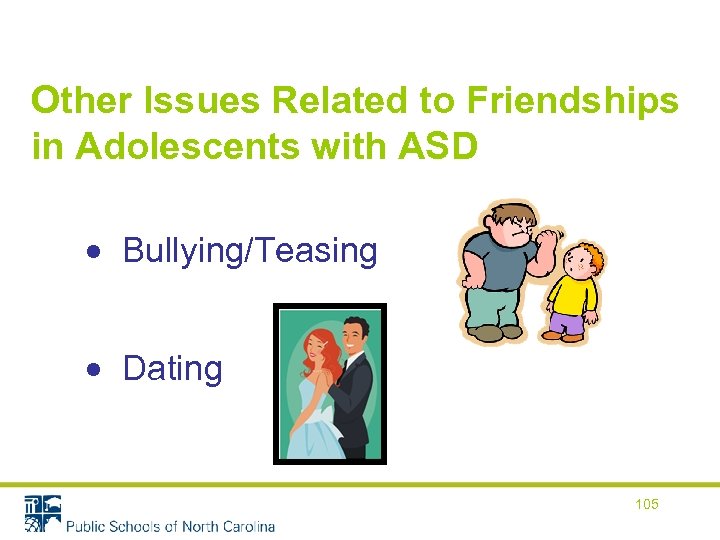 Other Issues Related to Friendships in Adolescents with ASD Bullying/Teasing Dating 105
Other Issues Related to Friendships in Adolescents with ASD Bullying/Teasing Dating 105
 Bullying/Teasing Individuals with autism are often socially different, thus making them targets for bullying or teasing Specific issues related to individuals with autism and bullying: – Recognizing/Reporting bullying – Lacking the social skills to respond appropriately Preventative strategies are key, as is teaching the skills to handle bullying 106
Bullying/Teasing Individuals with autism are often socially different, thus making them targets for bullying or teasing Specific issues related to individuals with autism and bullying: – Recognizing/Reporting bullying – Lacking the social skills to respond appropriately Preventative strategies are key, as is teaching the skills to handle bullying 106
 Bullying Resources Gray’s Guide to Bullying (Jenison Autism Journal) Perfect Targets by Rebekah Heinrichs The Bully, the Bullied, and the Bystander: From Preschool to High School by Barbara Coloroso Kidscape. org. uk Stopbullyingnow. hrsa. org 107
Bullying Resources Gray’s Guide to Bullying (Jenison Autism Journal) Perfect Targets by Rebekah Heinrichs The Bully, the Bullied, and the Bystander: From Preschool to High School by Barbara Coloroso Kidscape. org. uk Stopbullyingnow. hrsa. org 107
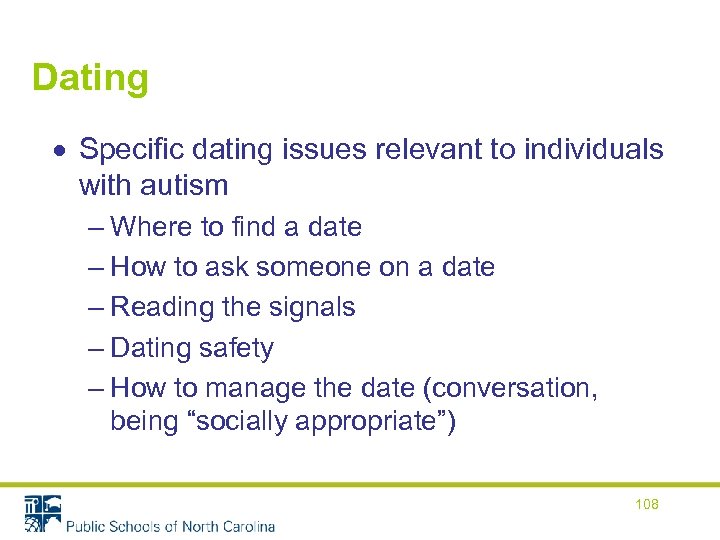 Dating Specific dating issues relevant to individuals with autism – Where to find a date – How to ask someone on a date – Reading the signals – Dating safety – How to manage the date (conversation, being “socially appropriate”) 108
Dating Specific dating issues relevant to individuals with autism – Where to find a date – How to ask someone on a date – Reading the signals – Dating safety – How to manage the date (conversation, being “socially appropriate”) 108
 Dating Resources “How to” or “Dating 101” books can give explicit, concrete rules about dating Jed Baker’s book, Preparing for Life, includes a section on dating that is appropriate for individuals on the spectrum 109
Dating Resources “How to” or “Dating 101” books can give explicit, concrete rules about dating Jed Baker’s book, Preparing for Life, includes a section on dating that is appropriate for individuals on the spectrum 109
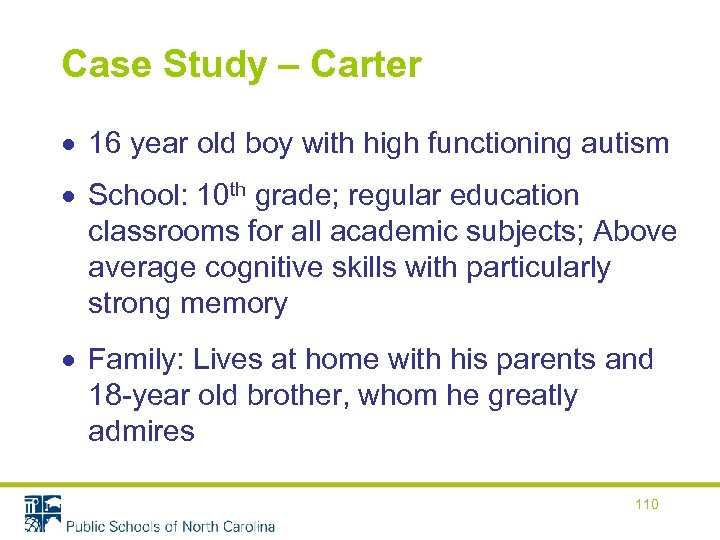 Case Study – Carter 16 year old boy with high functioning autism School: 10 th grade; regular education classrooms for all academic subjects; Above average cognitive skills with particularly strong memory Family: Lives at home with his parents and 18 -year old brother, whom he greatly admires 110
Case Study – Carter 16 year old boy with high functioning autism School: 10 th grade; regular education classrooms for all academic subjects; Above average cognitive skills with particularly strong memory Family: Lives at home with his parents and 18 -year old brother, whom he greatly admires 110
 Carter (cont. ) Interests: Carter is very interested in politics, sports statistics, and geography Social: Very sweet, but comes across as “geeky” to typical peers; speaks very matter-offactly and sometimes takes a while to process language; Recently, has developed an interest in dating girls 111
Carter (cont. ) Interests: Carter is very interested in politics, sports statistics, and geography Social: Very sweet, but comes across as “geeky” to typical peers; speaks very matter-offactly and sometimes takes a while to process language; Recently, has developed an interest in dating girls 111
 Activity The school dance is approaching and Carter would like to go. He does not have a preference about which girl he asks, but does not want to go alone Brainstorm the components that may cause Carter trouble with asking a girl to the dance Then come up with ways you would address these difficulties with Carter 112
Activity The school dance is approaching and Carter would like to go. He does not have a preference about which girl he asks, but does not want to go alone Brainstorm the components that may cause Carter trouble with asking a girl to the dance Then come up with ways you would address these difficulties with Carter 112
 Activity Good work! Your preparation with Carter paid off— he asked Olivia to the dance and she said yes! Now the next hurdle will be making sure the evening goes smoothly Brainstorm potential difficulties Carter may face with the dance Then come up with ways to address these difficulties beforehand 113
Activity Good work! Your preparation with Carter paid off— he asked Olivia to the dance and she said yes! Now the next hurdle will be making sure the evening goes smoothly Brainstorm potential difficulties Carter may face with the dance Then come up with ways to address these difficulties beforehand 113
 SECTION 6 Cooperative groups Hanging out with friends Preparing for jobs Self-advocacy language 114
SECTION 6 Cooperative groups Hanging out with friends Preparing for jobs Self-advocacy language 114
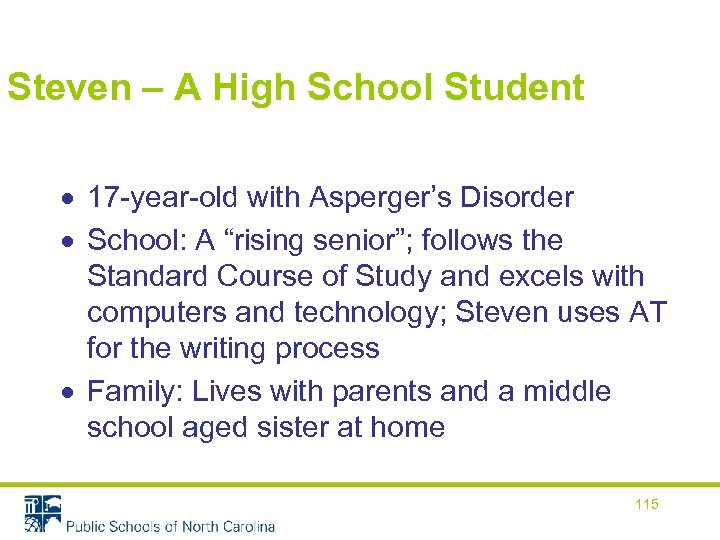 Steven – A High School Student 17 -year-old with Asperger’s Disorder School: A “rising senior”; follows the Standard Course of Study and excels with computers and technology; Steven uses AT for the writing process Family: Lives with parents and a middle school aged sister at home 115
Steven – A High School Student 17 -year-old with Asperger’s Disorder School: A “rising senior”; follows the Standard Course of Study and excels with computers and technology; Steven uses AT for the writing process Family: Lives with parents and a middle school aged sister at home 115
 Steven (cont. ) Interests: Likes all things “computer related” and reading science fiction books; has one same-aged friend with similar interests; no community-based activities outside church attendance at this time Social: Has challenges with transitions, anxiety, and peer social interactions in school, especially outside the structured classroom Special challenges: Faces post high school tasks that include work vs. education and independence related to demands of this new life phase 116
Steven (cont. ) Interests: Likes all things “computer related” and reading science fiction books; has one same-aged friend with similar interests; no community-based activities outside church attendance at this time Social: Has challenges with transitions, anxiety, and peer social interactions in school, especially outside the structured classroom Special challenges: Faces post high school tasks that include work vs. education and independence related to demands of this new life phase 116
 Activity – Steven’s Writing Tasks Read case story about Steven Pair with a partner - What technology, might be available in your school system to support Steven’s writing challenge? Compile a list of writing supports 117
Activity – Steven’s Writing Tasks Read case story about Steven Pair with a partner - What technology, might be available in your school system to support Steven’s writing challenge? Compile a list of writing supports 117
 The “Hidden Curriculum” Unspoken “rules” of the high school social situation Learning the rules of the new territory is a major high school challenge “Teens with ASD need to learn the subtext of social situations” (Scile- Kira, 2006, p. 149 ) 118
The “Hidden Curriculum” Unspoken “rules” of the high school social situation Learning the rules of the new territory is a major high school challenge “Teens with ASD need to learn the subtext of social situations” (Scile- Kira, 2006, p. 149 ) 118
 Steven’s Post High School Challenges Computer job with “best fit” Anxiety reduction in new social situations Housing/Living situation following high school Summer job possibilities Community programs for socialization 119
Steven’s Post High School Challenges Computer job with “best fit” Anxiety reduction in new social situations Housing/Living situation following high school Summer job possibilities Community programs for socialization 119
 Activity – Steven Post High School Challenges Divide into groups Brainstorm as a group topics listed § Jobs - computer based § Housing - local § Summer jobs - paid and unpaid § Community program supports 120
Activity – Steven Post High School Challenges Divide into groups Brainstorm as a group topics listed § Jobs - computer based § Housing - local § Summer jobs - paid and unpaid § Community program supports 120
 Anxiety in Social Situations Scripted activities Role playing Peer mediated activities Task adaptations 121
Anxiety in Social Situations Scripted activities Role playing Peer mediated activities Task adaptations 121
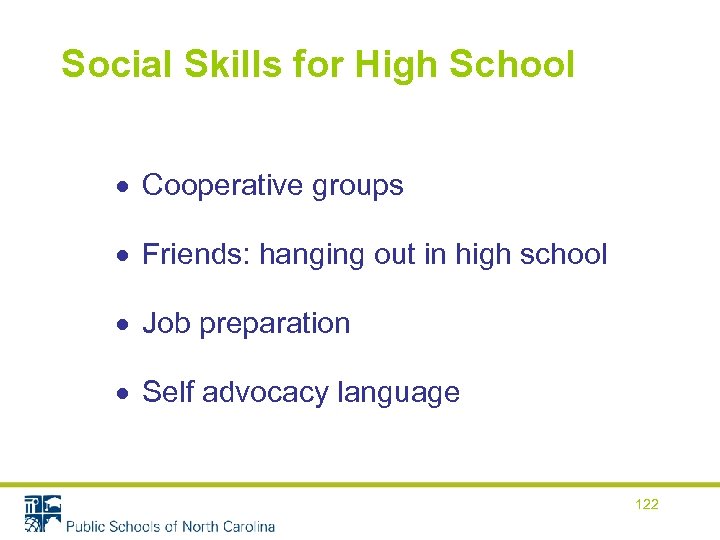 Social Skills for High School Cooperative groups Friends: hanging out in high school Job preparation Self advocacy language 122
Social Skills for High School Cooperative groups Friends: hanging out in high school Job preparation Self advocacy language 122
 Activities – Social Skills for High School Transition documents Plus/Delta chart on collaboration between support staff and general education re: students with ASD Graphic organizer of school day - fewer adult directed situations 123
Activities – Social Skills for High School Transition documents Plus/Delta chart on collaboration between support staff and general education re: students with ASD Graphic organizer of school day - fewer adult directed situations 123
 Activity: Collaboration Plus (+) Delta (∆) 124
Activity: Collaboration Plus (+) Delta (∆) 124
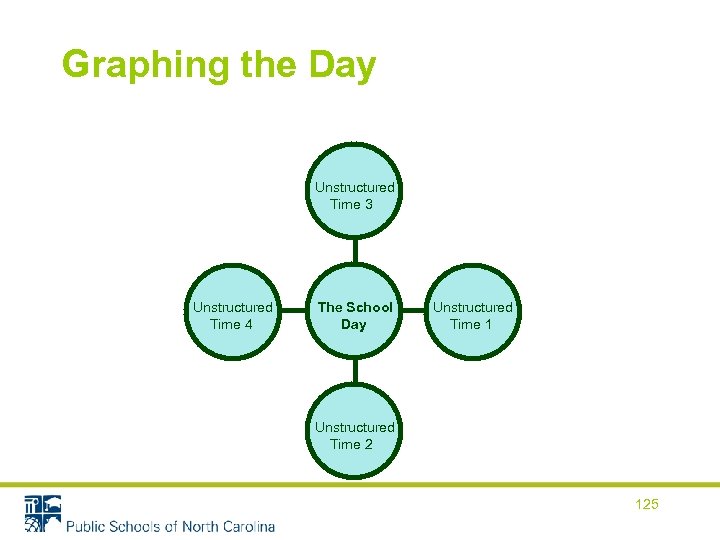 Graphing the Day Unstructured Time 3 Unstructured Time 4 The School Day Unstructured Time 1 Unstructured Time 2 125
Graphing the Day Unstructured Time 3 Unstructured Time 4 The School Day Unstructured Time 1 Unstructured Time 2 125
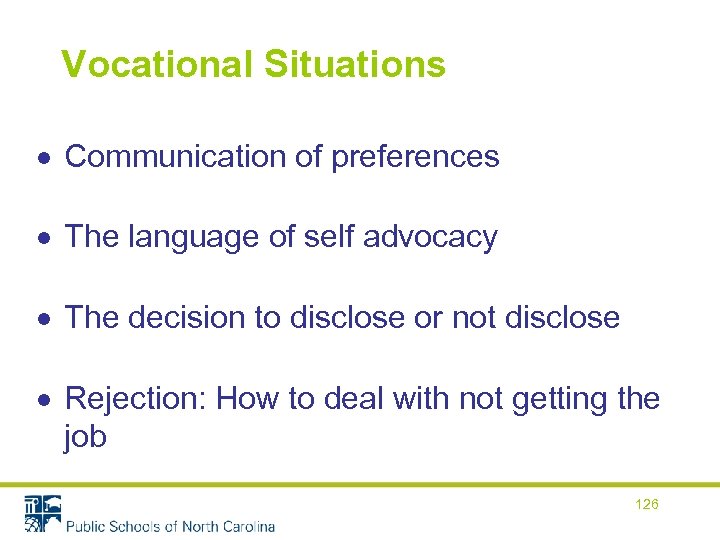 Vocational Situations Communication of preferences The language of self advocacy The decision to disclose or not disclose Rejection: How to deal with not getting the job 126
Vocational Situations Communication of preferences The language of self advocacy The decision to disclose or not disclose Rejection: How to deal with not getting the job 126
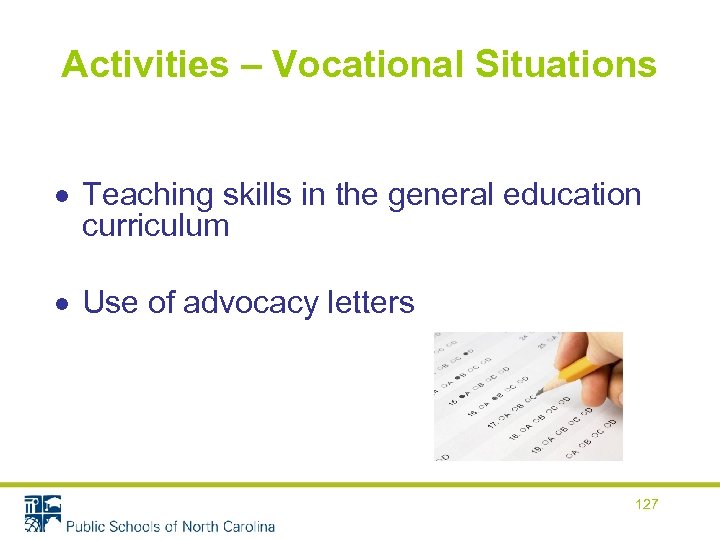 Activities – Vocational Situations Teaching skills in the general education curriculum Use of advocacy letters 127
Activities – Vocational Situations Teaching skills in the general education curriculum Use of advocacy letters 127
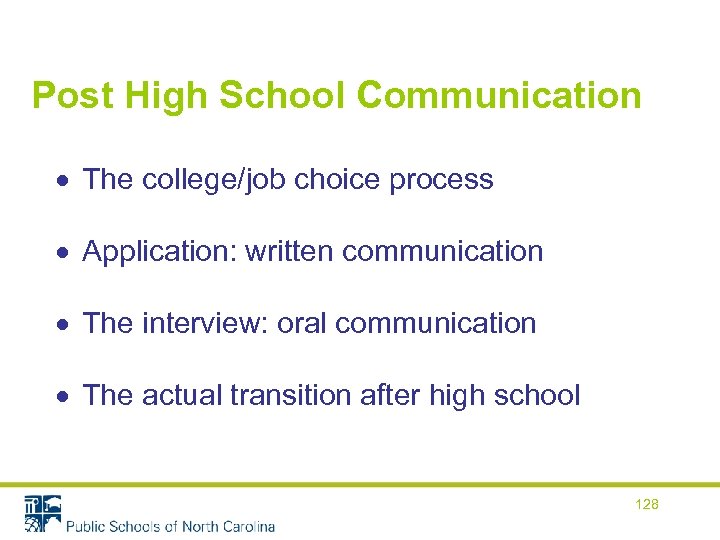 Post High School Communication The college/job choice process Application: written communication The interview: oral communication The actual transition after high school 128
Post High School Communication The college/job choice process Application: written communication The interview: oral communication The actual transition after high school 128
 The Transition Plan Make thoughtful updates at each annual review Look at student’s independence on the social-communication continuum Decide when and if vocational rehabilitation is to be involved 129
The Transition Plan Make thoughtful updates at each annual review Look at student’s independence on the social-communication continuum Decide when and if vocational rehabilitation is to be involved 129
 The Language of Life Skills Dates and social activities Handling emergencies Accessing a support system Everyday issues 130
The Language of Life Skills Dates and social activities Handling emergencies Accessing a support system Everyday issues 130
 Business Card Format for Sharing Information Steven Smith High School Street Sandy Hill High School. My Town NC 12345 Phone: 555 -5555 Fax: 555 -5555 E-mail: steven@example. com Student 131
Business Card Format for Sharing Information Steven Smith High School Street Sandy Hill High School. My Town NC 12345 Phone: 555 -5555 Fax: 555 -5555 E-mail: steven@example. com Student 131
 THE END 132
THE END 132
 APPENDIX Case Stories – Optional discussion questions Reference and Resource List 133
APPENDIX Case Stories – Optional discussion questions Reference and Resource List 133
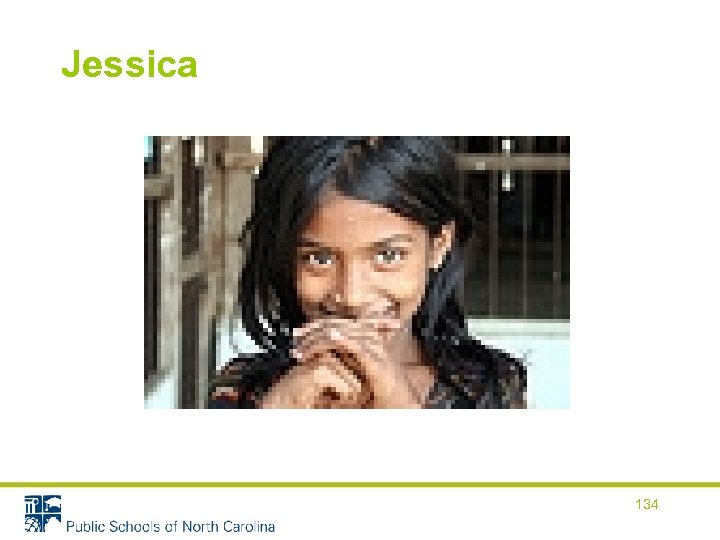 Jessica 134
Jessica 134
 Carter 135
Carter 135
 Paul 136
Paul 136
 Steven 137
Steven 137


